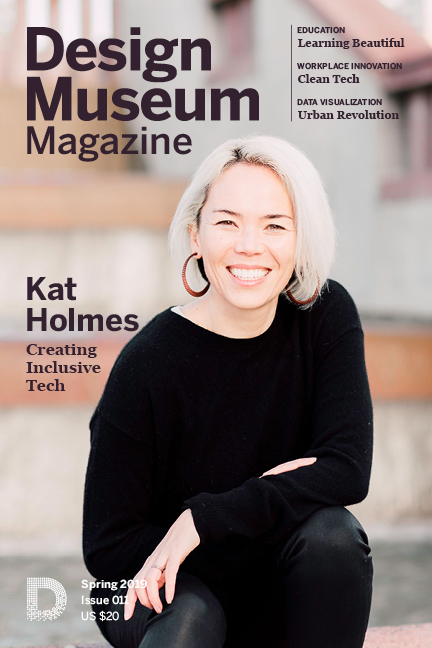Learning Beautiful
Building computer skills without computers
Computer science seems complex. From Boolean logic to algorithms, computer architecture and data structures, a dizzying spectrum of elements all weave together as an intricate system – a system almost as complex as language.

At Battery Park Montessori in New York, Learning Beautiful tools, like the Binary Tree shown here, are part of everyday play.
By Kim Smith, Co-Founder & CEO of Learning Beautiful; photos courtney Lailey, Green Ivy Schools
And yet here I am, writing, composing words with grammar, and you are able to read it. We understand the same larger system.
We learn this system at a young age. Playing with tactile ABC blocks and hearing sounds everyday, we grow to explore small elements of larger ideas, like words. And then we develop an intuitive sense of even larger and more complex relationships, like analogies.
So why isn’t computer science taught the same way? After all, computational thinking – the concepts and practices we use to solve problems and organize systems of information that are central to computer science – is just one of many kinds of thinking that is relevant to our world today.
Creating Learning Beautiful has been a long journey of design, research, and testing, and it all began with that simple observation: computational thinking is a necessary skill for today, and maybe it can be taught in a tactile, playful way. First as a research project at the MIT Media Lab, and now a spinout company dedicated to providing young children with developmentally-enriching foundational skills, Learning Beautiful creates timeless toys that teach young children the basics of computer science – without using computers.
Media Lab Social Computing Group
In the Social Computing Group at the MIT Media Lab, we often had trouble defining what is was that we did exactly. But we always knew what we were about. Every project started with values, and perhaps a simple question, and grew collaboratively. We were artists, designers, computer scientists, architects, filmmakers, yogis, philosophers, and educators. My own background is in art, design, and education. Together, we designed crash-course sessions in the lab, and we would teach each other things like drawing, or programming, or have discussions about the philosophy of economics. We embraced large, complex ideas that matter to communities, and we used design to explore their basic elements. Our projects were collaborations that explored how to put the basic elements back together.
One of our biggest projects was to reimagine what schools mean to neighborhoods. A network of small schools, located in shop fronts, could be embedded in communities and use the neighborhood as a classroom. We called them Wildflower schools, and we have been inspired to watch them grow to 21 schools in the few years since the first shop front opened in Cambridge, MA.
The Montessori method was a perfect pedagogy to adopt in Wildflower schools, because it stressed child-driven learning, mixed age groups, intrinsic motivation, exploratory play, and above all, a beautiful environment. The Montessori classroom is filled with highly sensorial materials. These playful objects are, in many ways, physical models of abstract concepts. Children at young ages crave things that are concrete and literal – they are drawn to building blocks, beads, and sticks. And the beauty of Montessori is that the objects embody mathematical or linguistic or musical relationships, and they are sequential, aligning with children’s developmental stages. Playing with them encourages children to construct mental models and develop intuitive knowledge.
Most people can think back to a time in childhood and remember a specific toy or object that evoked a transformative experience. For me it was as simple as a set of pencils and my sketchbook. They were transformative because of the world they allowed me to create. Physical objects have the power to shape a child’s learning experience and establish deep models that will serve them throughout their lives. The architect Frank Lloyd Wright attributed his spatial intuition to Froebel’s Gifts, a series of objects that revealed proportional relationships. Seymour Papert, an early proponent of computer science education, was forever changed by the “Gears of My Childhood.”
Papert called his gears an “object-to- think-with,” because they were embedded with formal mathematical systems. He wrote of the importance of the gears in constructing his knowledge because they were part of his natural landscape, he could use his body to think with them – imagining how they work through understanding how his own body turned. In this sense, an experience with a physical material has the transitive quality to build the mental models in our minds. “Anything is easy if you can assimilate it to your collection of models,” wrote Papert.
The more we considered the relationship between abstract ideas and physical forms, and the more we learned about the Montessori method and its materials, the more we returned to this simple observation: there is an opportunity to provide hands-on computer science learning that enriches young minds in developmentally-appropriate ways.
Considering the beauty and effectiveness of a hands-on pedagogy, we were puzzled that today, early childhood education in contemporary skills such as computer science relies so heavily on digitally mediated experiences. Many educational materials and toys available further separate children from their physical world. The proliferation of educational apps, and intro coding lessons further instill a child’s role as a computer user, without allowing them to directly learn the basic ideas behind how a computer works.
When we started this project in the Media Lab, the concept was simple: create new Montessori-inspired learning materials that address skills for today. We organized all-day hack-a-thons that brought together our lab with computer scientists, and with Montessori experts and teachers. We organized ourselves into groups around simple concepts that were not already in the Montessori classroom. We sketched and talked and brainstormed, and pieced together cardboard prototypes, or laser-cut simple things in the machine shop. At the end of the day, we had several simple prototypes that all demonstrated new skills. We started fast, but learned to refine more slowly.
Together with my collaborator, Yonatan Cohen, we designed and developed new learning materials for teaching computer science to young children, using the Montessori- inspired approach that isolates core concepts in physical, sensorial materials. The result is a series of objects made with natural materials to demonstrate such concepts as binary counting, image representation, algorithms, data structures, Boolean logic, sorting, and patterns.
At MIT, we were surrounded by the world’s greatest computer scientists, educators, designers. We had an array of rapid prototyping tools at our fingertips, and we had the Wildflower classrooms as close collaborators. We developed our scope and sequence for computational thinking with computer scientist, Sanjoy Mahajan, to represent a broad foundation of computational concepts that the basic building blocks behind how computers work. As a network, the scope and sequence weaves concepts in relationship to each other; the materials can be used independently, and in some cases, integrated simultaneously with other materials.
We spent the better part of 3 years making quick prototypes out of cardboard and wood scraps. Digital fabrication was an important part of our process – it allowed us to explore new ideas, and get them to a point that children could interact with them. We’ve learned that the most important things to get right usually aren’t so obvious – how an object feels in a child’s hand, or the sound a lid makes when it clacks shut – those are at the center of a child’s experience. So we had to find ways of quickly scaling to the size of a child’s hand, or find out the right level of detail, or try different materials that clacked and clattered and thumped. We also had to scrap or redesign the materials that either were confusing to teachers, or of little interest to the children.
And the Wildflower Schools were also a prototyping tool. We designed the shop front schools to be settings of constant creativity. The classrooms were a place for testing new ideas, and parents were excited to participate in the pursuit of innovative education. We would put our simple prototypes in the classroom, and see what stuck. Children are honest (sometimes brutally honest), and it is easy to quickly assess the effectiveness of a material. For over a year, we tested and refined materials, looking for what naturally engages a child’s attention. What calls to them? What are they returning to again and again? How are they (mis)using things, or developing whole new processes or games that we hadn’t thought of? Over the course of this design process, we cataloged our observations, constantly working to knit them together with pedagogical goals, through our ideology of learning.
Concepts & cardboard prototypes.
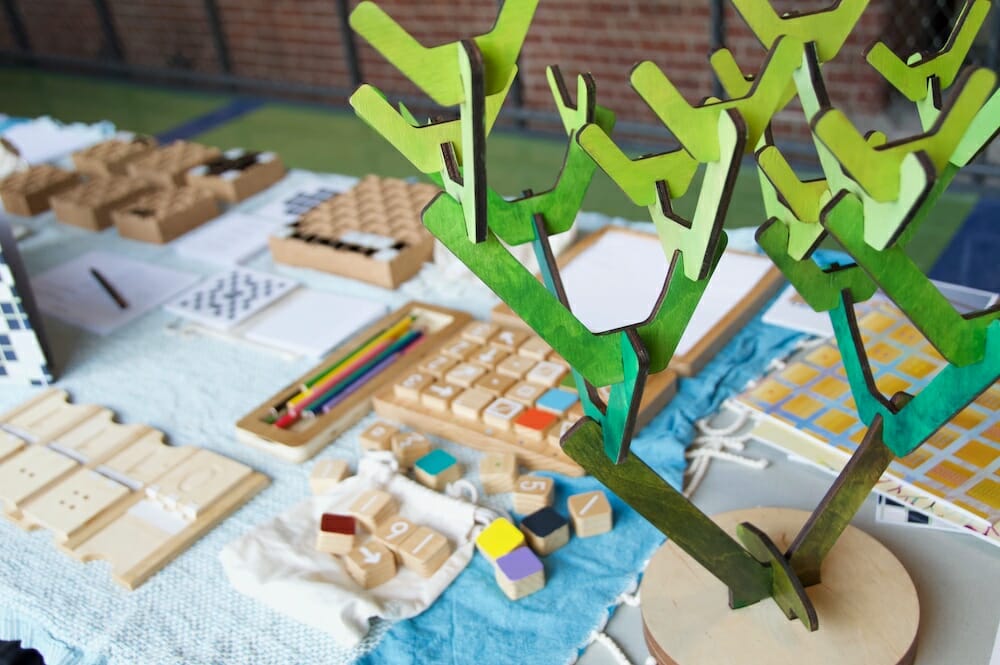
Learning Beautiful
We thought of our values and our desire to cultivate meaningful learning in beautiful ways, and named this project Learning Beautiful. One thing I valued about the Media Lab was the emphasis on creating real-world change through deployment beyond academia. By quickly deploying and testing in the Wildflower Schools, we were able to make changes and gain confidence in the work, while collaborating with children and teachers in order to direct the design process.
The concept of Learning Beautiful became my Master’s thesis; and during this process we refined the first 8 materials in the computational thinking curriculum and completed research to gather qualitative observations and insights into the effectiveness of this approach.
During our classroom observations and conversations with teachers, we identified patterns and developed our design principles. These principles were not simply ideological but were important indications of positive engagement and their potential for effective learning. For example, materials were designed for a range of ages, 3 to 9 – so that the youngest learners gained sensorial experiences that were much more experiential and playful; while older children may have had contextual conversations about how these ideas fit into their knowledge of computers. Careful aesthetic choices, and feedback from sounds, meant that children naturally gravitated toward them, and they were more engaged. Designing materials that can be used either individually or collaboratively allows children the opportunity to choose how they engage with the materials, and the older children were likely to use the materials to develop new games with their friends.
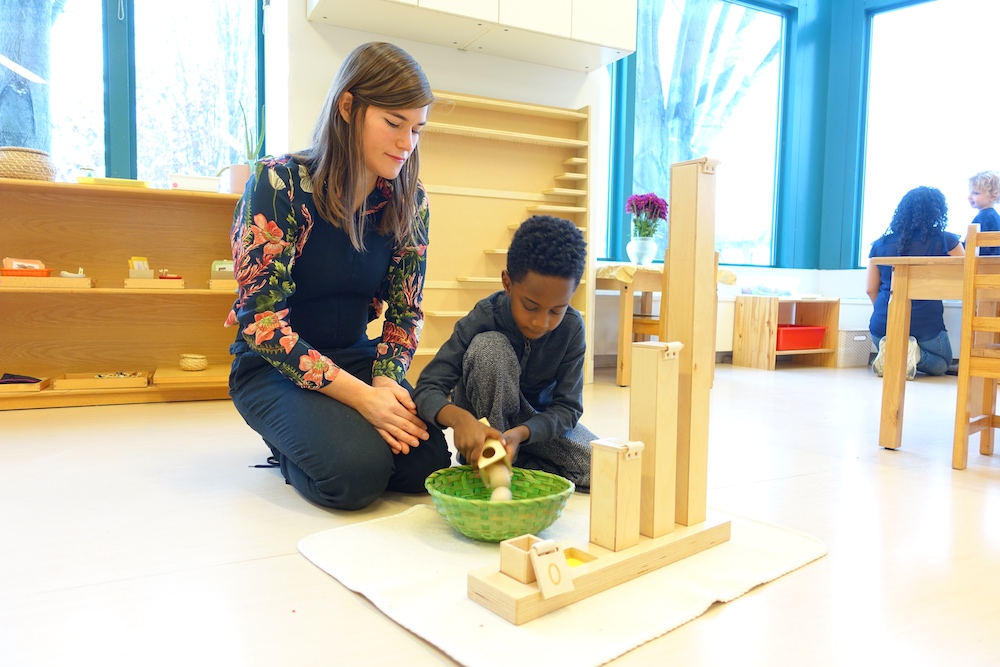
Design Principles
Sensorial. Materials are artifacts that embody abstract ideas, allowing children to use all of their senses in a way that is developmentally appropriate and thoughtful for their own periods of growth. Sensorial materials appeal to all children, breaking down preconceptions of aptitude and crossing learning styles.
Scaffolded. Big abstract systems are broken into smaller ideas that build off of one another, in concrete steps. By mastering them sequentially, children are constantly engaged as they build up confidence and understanding. This is articulated in lessons for each material, which are accessible to multiple age groups and various types of interaction, from playing independently to guided play to small groups.
Concrete. The materials provide tangible, physical engagement within the real world, allowing children to build their own mental model. In the future, when faced with more advanced applications of computer science, children integrate these models. Unlike most computer science education, these concrete materials are unmediated by a digital interface, allowing simple, clear, and direct interaction with concepts.
Cross-Contextual. Introducing computer science to young children in a variety of ways has the ability to engage children with all interests. Since computational thinking is really much broader than computer science, it can encompass a variety of skills that are shared across all disciplines.
Collaborative. Each material provides opportunity for either independent work or collaboration with peers. Most materials are intended to be accessible to a broad age range.
Beautiful. This is so important that is became part of our name: materials are aesthetically conscious, simple in design, and free from extraneous or distracting details.
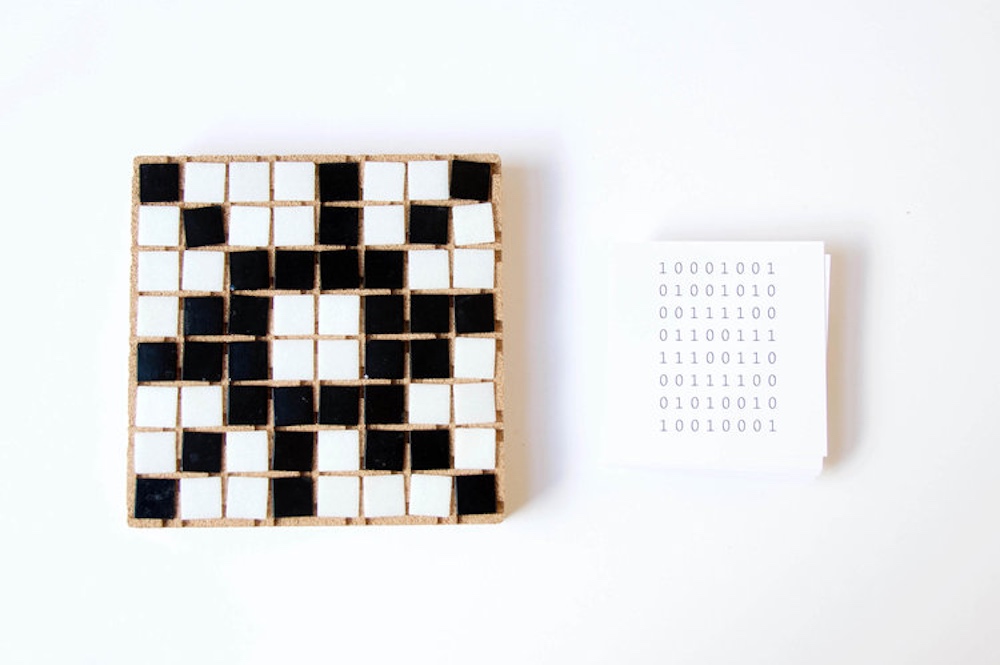
The Pixel Board demonstrates representation, how computers represent images.
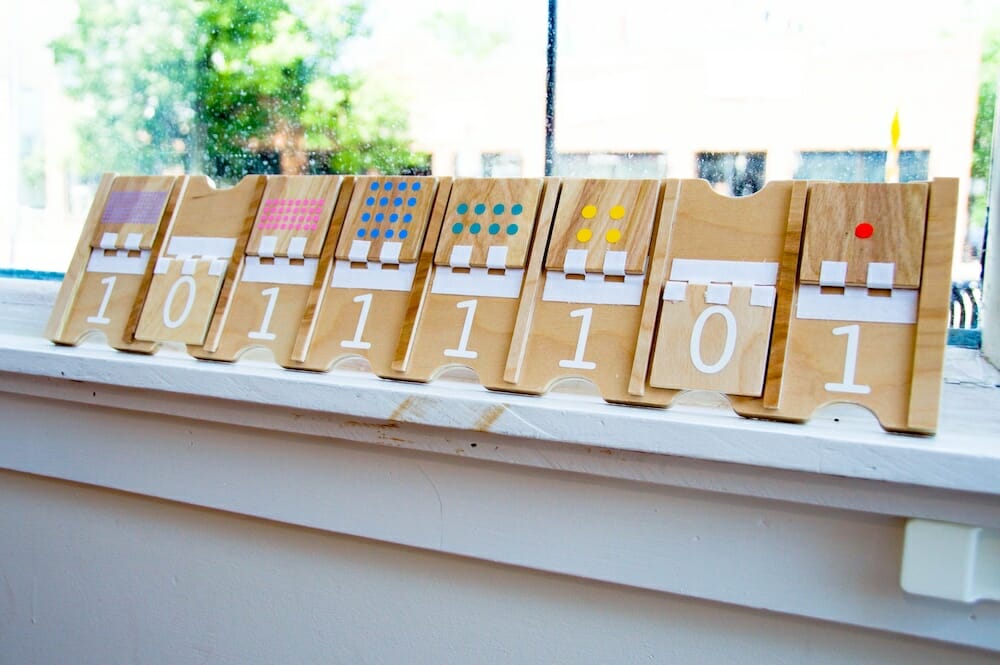
The Binary Cards introduce children to the binary number system.
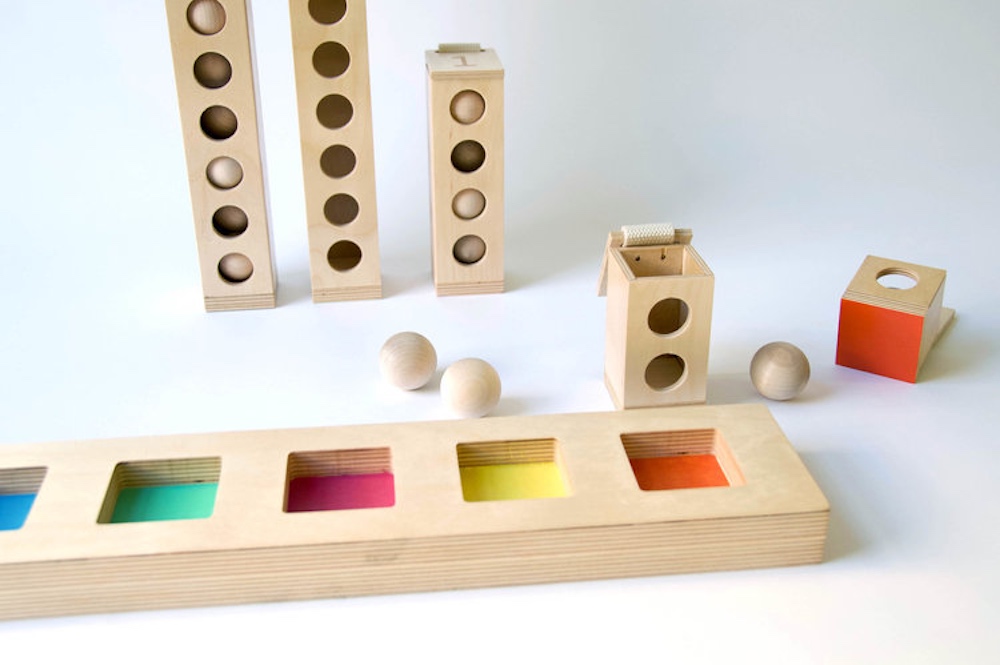
The Binary Towers demonstrate the ideas behind binary numbers: The towers are filled in order to discover the binary number for the corresponding quantity of balls.
What’s Next
After developing these materials, and observing them in the classroom, we were inspired to continue this work beyond MIT. We were accepted into MIT designX program – which prepares MIT designers with the skills to innovate and launch ventures – as well as MassChallenge, where we gained insights into building a company.
We began working with a fabricator in Milwaukee, Wisconsin call Stratus Industries, because we are dedicated to producing the highest quality products through ethical manufacturing. They have a wonderful team, dedicated to solving problems and collaborating with Learning Beautiful. They are recognized for their ethical and inclusive hiring practices: “With all employees, regardless of ability, it is about finding a place for them where they can use their strengths. In this situation, it’s a matter of being a bit more flexible and open minded. If someone has a great attitude, we will work to find a good fit for them,” says Lyle Stoflet, Jr., co-owner of Stratus, who has been hiring workers with disabilities to work on Learning Beautiful materials.
After launching in the Chicago Public Library in 2017, we began our Public Library Initiative. As libraries evolve to include new technologies and subjects, they continue to be a vital part of communities, and effectively reach diverse populations of children and their families, who may not otherwise have access to this education. In order to best serve this setting, we developed a series of children’s books that guide parents and children through the basic ideas behind the materials, and how to use them. We are currently active in science centers, libraries, and schools, and we are constantly working to advance the curriculum and develop more targeted modules. In 2019, we will be working on the second series of computational materials and developing a series of “DIY” activities that can be printed at home or use simple everyday objects. We are developing partnerships with organizations that serve communities abroad with less resources – where access to electricity or internet may be limited and wooden materials offer an effective alternative.
Our hope is that every aspect of Learning Beautiful, from the material sourcing to the manufacturing process, to the places where children interact with materials, can reinforce the mission of preparing all children to be creative and effective contributors to a better digital future.

